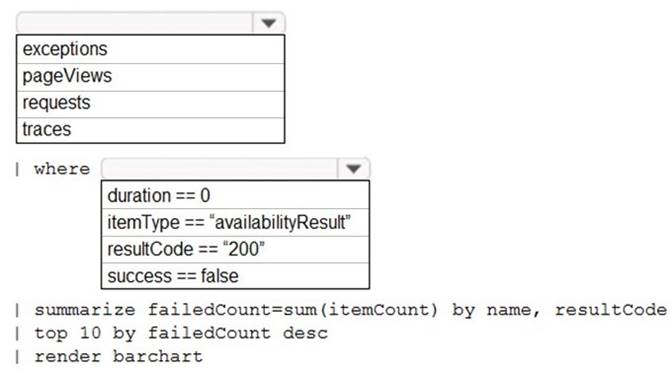- (Topic 4)
You have an on-premises app named App1 that accesses Azure resources by using credentials stored in a configuration file.
You plan to upgrade App1 to use an Azure service principal.
What is required for App1 to programmatically sign in to Azure Active Directory (Azure AD)?
Correct Answer:
C
https://docs.microsoft.com/en-us/azure/active-directory/develop/app-objects-and-service-principals "When you've completed the app registration, you've a globally unique instance of the app (the application object) which lives within your home tenant or directory. You also have a globally unique ID for your app (the app or client ID). In the portal, you can then add secrets or certificates and scopes to make your app work, customize the branding of your app in the sign-in dialog, and more."
- (Topic 4)
You have an Azure subscription that contains resources in several resource groups.
You need to design a monitoring strategy that will provide a consolidated view. The solution must support the following requirements:
• Support role-based access control (RBAC) by using Azure Active Directory (Azure AD) identities.
• Include visuals from Azure Monitor that are generated by using the Kusto query language.
• Support documentation written in markdown.
• Use the latest data available for each visual.
What should you use to create the consolidated view?
Correct Answer:
A
There are several tools available for running queries in Azure Data Explorer, including Kusto.
Kusto uses a role-based access control (RBAC) model, under which authenticated principals are mapped to roles, and get access according to the roles they're assigned.
Note: Azure Data Explorer is a highly scalable and secure analytics service that enables you to do rich exploration of structured and unstructured data for instant insights. Optimized for ad-hoc queries, Azure Data Explorer enables rich data exploration over raw, structured,
and semi-structured data delivering fast time to insight. Query with a modern, intuitive query language that offers fast, ad-hoc, and advanced query capabilities over high-rate data volumes and varieties
Reference:
https://docs.microsoft.com/en-us/azure/data-explorer/tools-integrations-overview
- (Topic 4)
You have an Azure DevOps project named Project1 and an Azure subscription named Sub1.
You need to prevent releases from being deployed unless the releases comply with the Azure Policy rules assigned to Sub1.
What should you do in the release pipeline of Project1?
Correct Answer:
B
You can check policy compliance with gates.
You can extend the approval process for the release by adding a gate. Gates allow you to configure automated calls to external services, where the results are used to approve or reject a deployment.
You can use gates to ensure that the release meets a wide range or criteria, without requiring user intervention.
Reference:
https://docs.microsoft.com/en-us/azure/devops/pipelines/release/deploy-using-approvals
HOTSPOT - (Topic 4)
You have an Azure web app named Webapp1.
You need to use an Azure Monitor query to create a report that details the top 10 pages of Webapp1 that failed.
How should you complete the query? To answer, select the appropriate options in the answer area.
NOTE: Each correct selection is worth one point.
Solution:
Box 1: requests
Failed requests (requests/failed):
The count of tracked server requests that were marked as failed. Kusto code:
requests
| where success == 'False' Box 2: success == false
Does this meet the goal?
Correct Answer:
A
- (Topic 4)
Note: This question is part of a series of questions that present the same scenario. Each question in the series contains a unique solution that might meet the stated goals. Some question sets might have more than one correct solution, while others might not have a correct solution.
After you answer a question in this section, you will NOT be able to return to it. As a result, these questions will not appear in the review screen.
You need to recommend an integration strategy for the build process of a Java application. The solution must meet the following requirements:
• The builds must access an on-premises dependency management system.
• The build outputs must be stored as Server artifacts in Azure DevOps.
• The source code must be stored in a Git repository in Azure DevOps.
Solution: Configure the build pipeline to use a Hosted Ubuntu agent pool. Include the Java Tool Installer task in the build pipeline. Does this meet the goal?
Correct Answer:
A

